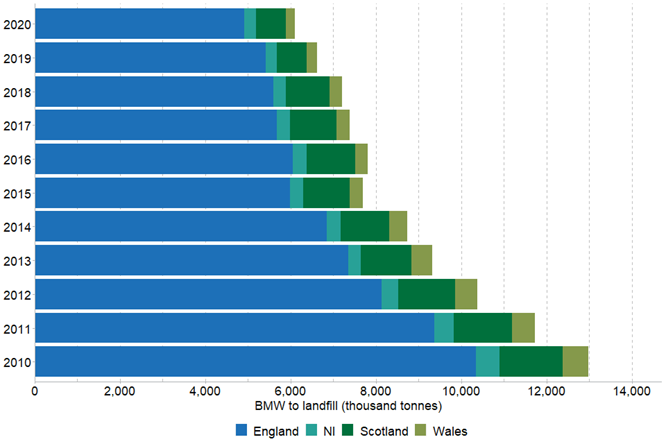Biodegradable Municipal Waste: Difference between revisions
No edit summary |
No edit summary |
||
| (9 intermediate revisions by 3 users not shown) | |||
| Line 1: | Line 1: | ||
[[Category:Tonnage & Waste Types]][[Category:Legislation & Policy]] | [[Biodegradable Municipal Waste]] ([[BMW]]) is the biodegradable fraction of [[Municipal Solid Waste]] | ||
[[Category:Tonnage & Waste Types]][[Category:Legislation & Policy]][[Category:Targets & Metrics]] | |||
== Overview == | == Overview == | ||
[[Biodegradable Municipal Waste]] ([[BMW]]) is the biodegradable fraction of [[Municipal Solid Waste]](generally around 50% by weight of [[MSW]]) is important as the UK has legally binding EU targets to deliver set reductions of [[BMW]] waste to landfill. These targets were originally addressed through individual targets on local authorities but they have now been lifted (in England); the primary reliance is now on the [[Landfill Tax]] and treatment systems under [[PFI]] funded schemes to deliver the objectives. | |||
== Targets == | == Targets == | ||
| Line 11: | Line 12: | ||
* No greater than 35% of the 1995 baseline by 2020 | * No greater than 35% of the 1995 baseline by 2020 | ||
and has progressively reduced year on year with | and has progressively reduced year on year with 6.1 million tonnes sent to [[Landfill]] in 2020, representing less than 20% of the 1995 baseline value<ref>[https://www.gov.uk/government/statistics/uk-waste-data UK Statistics on Waste March 2020] most recent 2018 data and finalized/revised May 2022</ref>. England is responsible for 81% of UK BMW to Landfill, generating 4.9 million tonnes of the 6.1 million tonnes in 2020. | ||
[[File:BMW to Landfill.png|frame|center|BMW to Landfill | [[File:BMW to Landfill.png|frame|center|BMW to Landfill (extract from DEFRA digest)]] | ||
== References == | == References == | ||
< | <references /> | ||
Latest revision as of 08:33, 7 June 2022
Biodegradable Municipal Waste (BMW) is the biodegradable fraction of Municipal Solid Waste
Overview
Biodegradable Municipal Waste (BMW) is the biodegradable fraction of Municipal Solid Waste(generally around 50% by weight of MSW) is important as the UK has legally binding EU targets to deliver set reductions of BMW waste to landfill. These targets were originally addressed through individual targets on local authorities but they have now been lifted (in England); the primary reliance is now on the Landfill Tax and treatment systems under PFI funded schemes to deliver the objectives.
Targets
The targets outlined below (and which the UK is expected to meet), come from European Directive 1999/31/EC on the landfill of waste.
The amount of BMW to landfill as a target is measured against the 1995 baseline requiring:
- No greater than 75% of the 1995 baseline by 2010
- No greater than 50% of the 1995 baseline by 2013
- No greater than 35% of the 1995 baseline by 2020
and has progressively reduced year on year with 6.1 million tonnes sent to Landfill in 2020, representing less than 20% of the 1995 baseline value[1]. England is responsible for 81% of UK BMW to Landfill, generating 4.9 million tonnes of the 6.1 million tonnes in 2020.

References
- ↑ UK Statistics on Waste March 2020 most recent 2018 data and finalized/revised May 2022
